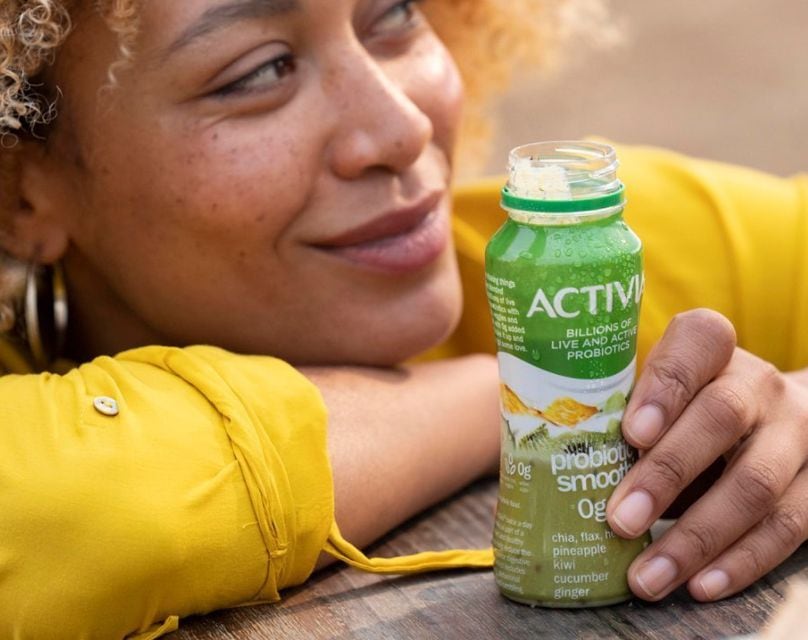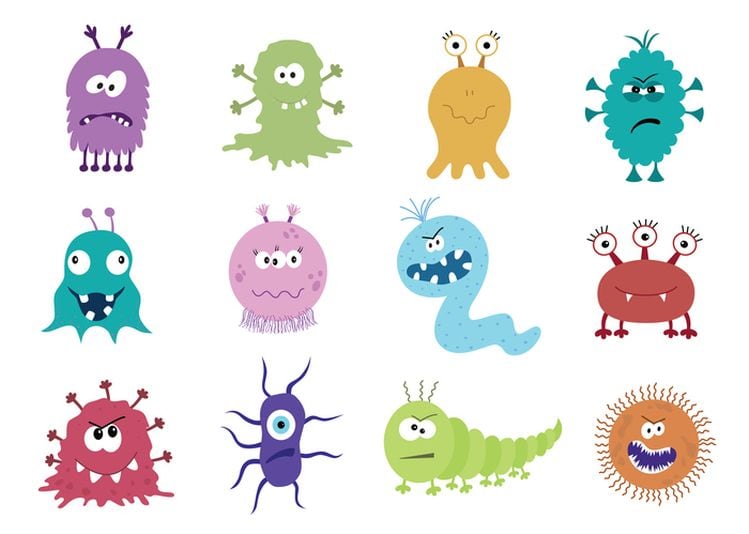Our understanding of the relationship between our health and the billions of microorganisms that populate our bodies is growing rapidly, says Dr Miguel Freitas; VP health and scientific affairs at Danone North America, which, with the Activia brand, recently helped fund a pioneering prospective cohort study at Rutgers University exploring whether microbiome health could explain why people respond differently to COVID-19.
We know, for example, that specific strains of ‘good bacteria’ such as Bifidobacterium animalis lactis DN-173 010/CNCM I-2494 (used in Activia yogurts) can help support gut health, while L. casei Danone CNCM I-1518 (used in DanActive shots) can help support the immune system. Studies on individual probiotic strains also show encouraging results in relation to atopic dermatitis, pediatric acute infectious diarrhea, antibiotic-associated diarrhea, irritable bowel syndrome, visceral fat reduction and even LDL-cholesterol reduction.
An increasing number of studies also show promising results for probiotics in oral care in children, liver health, bacterial vaginosis, and urinary tract infections.
Correlation vs causation
But there’s still a lot we don’t know, says Dr Freitas, who has been working with probiotics for 20 years. Take a ‘healthy’ gut: Is it all about having a wide diversity of bacterial populations, or is it more about the absence, presence, or preponderance of certain key bacteria?
“I don’t think today we have a definitive answer,” he says. “It’s probably a mix of both, having diversity, but also more of the bacteria we know are good. If you look at a recent [Sept 2020] study in the journal Nature Communications from Gupta et al [suggesting that you can pretty accurately predict human subjects’ health status by analyzing the bacteria in their stool samples], they were able to see which bacteria were more prevalent in individuals that had no disease.
“And something that was eye catching, was that four of the eight bacterial species that were more prominent in the healthy microbiomes were bifidobacteria, which is the first bacteria that colonize babies’ guts.
“That being said, most of these studies don’t have a cause/effect mechanism, so when you’re looking at relatively small numbers, the data is still preliminary.”
Probiotics and obesity: ‘The microbiome is pretty resilient’
As to whether we can attenuate or even reverse obesity and other metabolic disorders by modulating gut bacteria, we’re still learning, he says. For example, we know that the gut bacteria of obese and lean animals and people are different, prompting researchers to wonder if the presence of absence of certain bacterial populations is simply a reflection of obesity or is partly responsible for it (begging the question, can we 'reverse' obesity by altering our gut bacteria)?

A tantalizing animal study published in 2006 showed that if you transfer the microbiota of obese and lean mice into germ-free mice, and then feed them exactly the same diet, the mice populated with the ‘obese’ gut bacteria will experience a greater increase in body fat, suggesting that our gut bacteria are directly influencing body composition and weight.
A 2013 study went on to show that a single endotoxin-producing Enterobacter species isolated from a morbidly obese human gut was sufficient to induce obesity and insulin-resistance in germ-free mice fed a high-fat diet, again suggesting a causative role for gut bacteria in obesity.
Other studies, meanwhile, have shown that you can even restore insulin sensitivity in people with metabolic syndrome by giving them gut microbiota from lean people.
However, more recent studies investigating the effects of oral fecal microbiota transplantation (FMT) from healthy lean donors and their ability to alter gut microbiota and improve metabolic outcomes in obese patients have been inconclusive and more research is needed to better understand how different species of bacteria in the gut microbiome may affect weight gain, and to determine the most appropriate dietary regimens for long-term weight control, says Dr Freitas.
One thing we are learning, he notes, is that short term studies are one thing, but what really matters is whether some of these interventions really work over the longer term: “The microbiome is pretty resilient. Even a transplant from one person to another, after a certain time, it comes back.”
‘The microbiome is fairly resilient; it can be disturbed temporarily but also corrected; the problem is that our modern life is a kind of constant disturbance’
So what do we know about the impact of factors such as c-sections, formula-feeding, antibiotic use, and the ‘western’ diet? Will these things impact our microbiome – and subsequently our health - for life, or can we reverse or counter their effects though dietary interventions?
“Some things might actually affect us for the rest of our lives, but some, no,” says Dr Freitas. “We all have unique, individual microbiomes, it’s like a fingerprint, and western diets, antibiotic use or even just stressful events or lack of sleep are correlated to changes in the microbiome,” temporary effects that can be countermanded through dietary interventions, such as taking certain probiotics if you are prescribed antibiotics (that can wipe out good and bad bacteria alike).
“The microbiome is fairly resilient; it can be disturbed temporarily but also corrected, the problem is that our modern life is a kind of constant disturbance, so more and more we need to consume a diet that can take care of the microbiome, which could be a dietary pattern approach with lots of high fiber fruits and vegetables, fermented foods, and things like postbiotics; you don’t just have to consume live bacteria.”
As for the new kid on the functional ingredients block, postbiotics – which are not live organisms – it's definitely an area to watch, he says: “Actually in my PhD* back in 2001, I was trying to understand how a probiotic impacted the defense system in the gut, and my hypothesis was that it was not necessarily the bacteria itself, but what it was producing, that was influencing the immune cells, so 20 years ago the postbiotic concept was already in my mind!”
For cynics suspecting our guts can function perfectly well without the ingestion of a daily dose of ‘good’ bacteria, Dr Freitas points out that until relatively recently, this was probably the case.
However, several factors have combined in the last 70+ years to upset the delicate balance of our internal microflora, he claims, from the rise in c-sections and less breastfeeding, to antibiotic use, stress, poor diet, and a more sanitized environment.
Probiotic consumption/frequency
When it comes to frequency of consumption, meanwhile, beneficial bacteria will not populate the gut for ever if you only eat them for a couple of weeks, he observes. “Typically probiotics are not permanently colonizing the digestive system.”
To commentators that argue that this proves that probiotics ‘don’t work,’ that’s like saying that vitamins don’t ‘work’ because you consumed vitamin C for two weeks and expected to be scurvy-free for a lifetime, he says. Whether it’s vitamins, a fiber-rich diet, or ‘good bacteria,’ it stands to reason that for optimal health, you should consume them regularly throughout your life.
‘The early education of the immune system is done through bacteria’
As for timing, our exposure to certain types of beneficial bacteria during key early developmental windows appears to be critical to the development of the immune system, he says.
Evolve Biosystems for example, has talked about the ‘generational loss’ of B. infantis in infants, likely due to multiple factors including formula feeding, c-sections and antibiotic use. And while correlation is not causation, we know that babies with low levels of B.infantis - which crowds out pathogenic bacteria in the gut and has been shown to digest human milk oligosaccharides in breast milk - are more likely to develop allergic and autoimmune conditions as they grow up.
“We do know that kids born through c-sections have a higher incidence of allergies and asthma later in life and that’s not something you can necessarily correct [once they emerge from infancy, given that the immune system is built early in life]," says Dr Freitas.
“It’s about the early education of the immune system, which is done through bacteria.”
The hygiene hypothesis
He also highlights the so-called ‘hygiene hypothesis,’ which suggests that our obsession with creating a more sanitary environment has weakened our immune systems, something backed up by multiple studies, including a 2015 Swedish study showing allergies in children from families who wash dishes by hand were less common than in children from families who use dishwashers [which creates a far more sterile environment].
Consumer understanding of probiotics
When it comes to consumer understanding of probiotics and gut bacteria, there has definitely been an evolution, says Dr Freitas.

“I moved to the US in 2004 and very quickly I realized that the American understanding of the benefits of good bacteria was extremely limited, even among doctors. I think it’s because of the whole focus on creating a sterile environment. But since Danone launched Activia in the US in 2006, it definitely changed the mindset.”
While COVID-19 has undoubtedly accelerated consumer interest in probiotics for gut health and immunity, awareness has been growing steadily over the past decade, he says.
“I believe there are two main types of probiotics consumers: probiotic seekers, who read labels and understand that not all probiotics are the same; and people that are just looking for ‘probiotics’ for health and are not looking for a particular benefit.”
Fermented foods and probiotics
That said, while US consumers generally understand that probiotics are live micro-organisms, and that there are so-called ‘friendly’ or ‘good’ bacteria as well as the bugs they’re trying to kill with cleaning products, they don’t necessarily understand that not all fermented foods (kombucha, sauerkraut, kombucha, kimchi) contain probiotics (defined by the WHO as 'live microorganisms that, when administered in adequate amounts, confer a health benefit on the host'), says Dr Freitas.
As the benefits of probiotics are strain-specific, when you see generic references to ‘probiotics’ on the front of a product label, but you turn over the pack and the strains are not listed, it raises a red flag, he says, noting that many fermented foods may contain probiotics, but the organisms in many of these products have typically not been studied.
“If you’ve got the strain listed then consumers can do their research and see if that strain is backed up by clinical studies.”
'Live and active cultures'
On a yogurt, for example, while some consumers believe ‘live and active cultures’ means probiotics, at a basic level, it just means that the product contains a certain amount of Lactobacillus bulgaricus and Streptococcus thermophilus (starter cultures that turn milk into yogurt) at the time of manufacture [according to the National Yogurt Association, the cultures must also be 'active' at the end of the stated shelf-life].
However, one clear side benefit of these cultures is that they break down lactose (milk sugar) and therefore improve the digestion of dairy products for people with lactose intolerance, which could technically be considered a ‘probiotic’ effect, observes Dr Freitas.
“It’s a very particular benefit, so it’s not about the immune system, for example. I’d say ‘yogurt has bacteria that helps with lactose intolerance.’”
The gut-brain axis
At Danone, the focus right now is on pre- and probiotics for consumers throughout their lifecycle, says Dr Freitas, who highlights the recent launch of Super Danimals, dairy smoothies for kids featuring the probiotic strain ‘L.Casei Immunitas’ (Lactobacillus Casei DN-114 001), that’s claimed to support the immune system).
“When it comes to my personal interest,” says Dr Freitas, who observes that antidepressants are often used to treat digestive disorders such as IBS (highlighting the relationship between the gut and the brain), “I’m very interested in the gut-mind connection, and also the influence of the microbiome on the brain and mood.

"Activia was a pioneer in this research a few years ago, and did one of the first studies showing that a probiotic could impact certain communications between cells in the brain.
“It didn’t bring us to a point where we could develop a claim or point to a particular benefit, but we’re still very interested in the gut brain connection. I follow a lot of this research.”
Personalized nutrition and the microbiome
Another area Dr Freitas believes will gain traction is personalized nutritional recommendations based on analyses of individual consumers’ microbiomes (via data obtained from stool samples).
There is already a plethora of companies in this space offering to analyze our fecal matter, and while some of the work “is a bit preliminary… people playing doctors on TV,” he observes, it’s an exciting field.
When it comes to fecal matter - something with which probiotic researchers are intimately acquainted - Danone has recently teamed up with the University of California, San Diego on the The Human Diets & Microbiome Initiative to secure fecal samples (and diet and lifestyle questionnaires) from 1,000 UK and US residents in the first phase of a program to map the gut microbiome of people around the world.
The samples are being analyzed using the latest sequencing technology, such as shotgun metagenomic sequencing, which enables scientists to comprehensively sample the genes of all organisms present in the gut microbiome, evaluate bacterial diversity and detect the abundance of microbes in the gut. Shotgun metagenomics will also enable researchers to study unculturable microorganisms that are otherwise difficult or impossible to analyze, he says.
Ultimately, he says, greater understanding of the relationship between health and our gut microbiome will enable highly targeted, personalized dietary interventions: “You can then select probiotics [or make other dietary recommendations] for their ability to address your specific imbalances or deficiencies.”
*Dr. Freitas earned a PhD from the National Institute of Health and Medical Research (INSERM) in Paris. His dissertation focused on how a specific strain of Lactobacillus Casei helps to support the immune system.

One of the things Dr Freitas is most proud of is Danone’s annual program to award grants to graduate students exploring everything from prebiotics in food, to the infant gut microbiome, an initiative that started eight years ago, he says.
(Danone is now accepting applications for the 2020-2021 Danone North America Gut Microbiome, Yogurt and Probiotics Fellowship Grant and will award two $25,000 grants to graduate students interested in exploring the gut microbiome, probiotics and yogurt. The deadline for entries is Feb 14, 2021).
“We also sponsor an annual meeting called the Gut Microbiota For Health World Summit; we sponsor several workshops dedicated to dietitians; and we partner with the American Gastroenterological Association as I believe companies like Danone have a role to play in educating healthcare professionals and consumers.”

